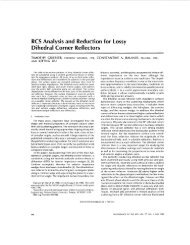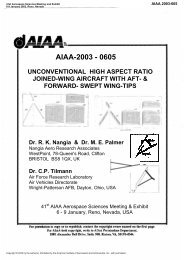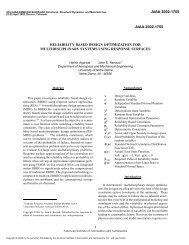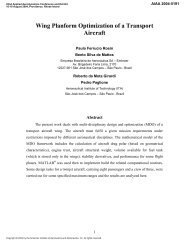Application of MDO to Large Subsonic Transport Aircraft
Application of MDO to Large Subsonic Transport Aircraft
Application of MDO to Large Subsonic Transport Aircraft
Create successful ePaper yourself
Turn your PDF publications into a flip-book with our unique Google optimized e-Paper software.
(c)2000 American Institute <strong>of</strong> Aeronautics & Astronautics or published with permission <strong>of</strong> author(s) and/or author(s)’ sponsoring organization.<br />
<strong>to</strong>ols it is possible <strong>to</strong> make accurate trade<strong>of</strong>f<br />
studies using multi-disciplinary optimization<br />
technology in the initial stage <strong>of</strong> aircraft<br />
definition. This <strong>to</strong>ol is similar <strong>to</strong> the MIDAS <strong>to</strong>ol<br />
[5] developed in the early ‘90s <strong>to</strong> design the<br />
Present Method<br />
In order <strong>to</strong> increase the accuracy <strong>of</strong> the initial<br />
preliminary design trade-<strong>of</strong>f, we developed a new<br />
wing preliminary design <strong>to</strong>ol. This is achieved by<br />
increasing the physical fidelity <strong>of</strong> the models and<br />
by using multi-disciplinary design optimization.<br />
This <strong>to</strong>ol was comprised out <strong>of</strong> three parts:<br />
a) Pointer MD0 framework. The purpose <strong>of</strong><br />
this <strong>to</strong>ol is <strong>to</strong> execute computer simulations<br />
more efficiently, and <strong>to</strong> search the design<br />
space created with the outputs <strong>of</strong> these<br />
simulations for the best solution.<br />
b) FAME-W weight and loads model<br />
developed by DASA-Airbus Hamburg. It<br />
determines the potentially best structural<br />
weight for a well designed aero-elastically<br />
deforming wing using only a preliminary<br />
description <strong>of</strong> the structure and ,aircraft<br />
mission.<br />
c) Globair aerodynamics model developed by<br />
Synaps and DASA-Airbus Bremen. It<br />
determines the potentially lowest transonic<br />
drag for a well designed wing for a given<br />
mission point using only a preliminary<br />
description <strong>of</strong> the wing surface.<br />
Pointer as a <strong>to</strong>ol <strong>to</strong> perform design studies.<br />
Pointer [6,9] is an MD0 framework <strong>to</strong>ol. MD0<br />
framework <strong>to</strong>ols are explained in detail by Salas<br />
and Townsend in ref. [7]. The development <strong>of</strong><br />
Pointer was driven by the following<br />
consideration:<br />
Pointer should give the expert user the ability <strong>to</strong><br />
find a better answer <strong>to</strong> a wide class <strong>of</strong> complex<br />
design problems in less time than it would take<br />
him <strong>to</strong> solve the problem in a conventional way.<br />
2<br />
American Institute for Aeronautics and Astronautics<br />
DASA & European supersonic transports.<br />
However because subsonic transports are much<br />
more mature, a much higher accuracy in the<br />
physical modeling is required <strong>to</strong> achieve<br />
(typically smaller) performance gains.<br />
Therefore, the setup <strong>of</strong> the design problem<br />
should be as user-friendly as possible. In terms <strong>of</strong><br />
the s<strong>of</strong>tware architecture Pointer achieves this by<br />
using intuitive GUI’s [Fig 21, object oriented<br />
principles and the use <strong>of</strong> s<strong>of</strong>tware standards.<br />
Pointer au<strong>to</strong>matically parses the parameters<br />
defining the input <strong>to</strong> legacy and proprietary<br />
codes. Pointer also controls the running <strong>of</strong> these<br />
codes both in sequence and parallel.<br />
After all the I/O is defined, the design problem is<br />
stated in the form <strong>of</strong> an objective, design<br />
variables and constraints. It is here that most<br />
users have problems and we consider this the<br />
major hurdle in the development <strong>of</strong> MD0<br />
technology.<br />
In his paper “On making things best” [lo] Holt<br />
Ashley said it all, when he stated the omission <strong>of</strong><br />
the optimization algorithm description in a<br />
design study a “charming sign <strong>of</strong> maturity”. In<br />
Pointer a hybrid combination <strong>of</strong> the best current<br />
optimization algorithms [Linear Programming,<br />
Sequential Quadratic Programming, Gradient,<br />
Downhill-simplex and Genetic] are used <strong>to</strong> solve<br />
the problem. The program does not require any<br />
intervention from the user or specialist know-<br />
ledge about optimization. In our experience,<br />
Pointer requires T hours <strong>to</strong> solve the problem:<br />
T = Z * #variables *Time-per-design- simulation<br />
Z, the relative complexity <strong>of</strong> the problem, is<br />
typically 100, the first time a strongly non-linear<br />
engineering problem is solved. We see the initial<br />
investment <strong>of</strong> so many function calls as essential<br />
<strong>to</strong> understanding the problem posed by the<br />
<strong>to</strong>pography <strong>of</strong> the objective function. In practice<br />
if the computer simulation takes more than I<br />
hour, parallel processing <strong>of</strong> the design simulation<br />
is required <strong>to</strong> avoid excessive run-times.<br />
In subsequent uses, Pointer learns from its<br />
experience and typically reduces Z <strong>to</strong> a number<br />
below 10. This saves a lot <strong>of</strong> time when<br />
optimizations are repeated, for instance when an<br />
optimal design database is created.


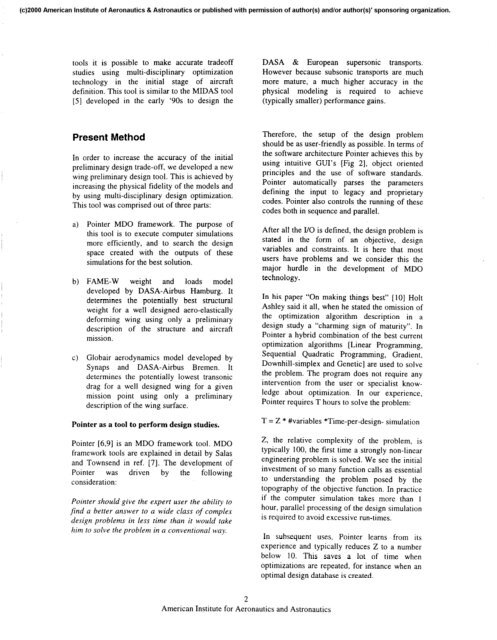





![Introduction to RF Stealth [Book Review] - Antennas and ...](https://img.yumpu.com/16857890/1/190x245/introduction-to-rf-stealth-book-review-antennas-and-.jpg?quality=85)

